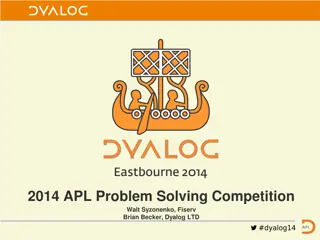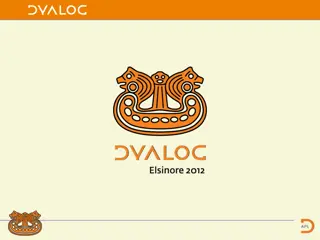APL - A Functional Language with Array Paradigms
APL, named after the book "A Programming Language Paradigms," is a functional language with a focus on array manipulation. Developed in the 1960s by Kenneth E. Iverson, it has had a significant impact on the development of spreadsheets and computer math packages. APL operates with chains of monadic or dyadic functions/operators acting on arrays, making it unique in its approach to computation. Originally used within IBM, APL gained mainstream attention with the availability of the IBM 1130 in 1967. An environment called a workspace allows for easy manipulation of data and programs. With nonstandard primitives and control structures, APL simplifies program flow and data structure management. Despite its simplicity in syntax, APL may require a special keyboard for optimal usage.
Download Presentation

Please find below an Image/Link to download the presentation.
The content on the website is provided AS IS for your information and personal use only. It may not be sold, licensed, or shared on other websites without obtaining consent from the author.If you encounter any issues during the download, it is possible that the publisher has removed the file from their server.
You are allowed to download the files provided on this website for personal or commercial use, subject to the condition that they are used lawfully. All files are the property of their respective owners.
The content on the website is provided AS IS for your information and personal use only. It may not be sold, licensed, or shared on other websites without obtaining consent from the author.
E N D
Presentation Transcript
APL TANNER SMITH ALEXA BREELAND TYLER SIMS
Overview Functional Language Named after the book A Programming Language Paradigms: Array, functional, structured, modular Important influence on development of spreadsheets, and computer math packages, such as MATLAB Still used today for certain applications, especially financial/mathematical applications Chains of monadic or dyadic functions/operators acting on arrays. Normally interpreted, not often compiled
History Developed in 1960s by Kenneth E. Iverson He developed a mathematical notation for manipulating arrays that he taught to his students while working at Harvard Iverson then worked at IBM in 1960 and created APL with Adin Falkoff. Originally used inside IBM for short research reports on computer systems and comparing stack machines versus register machines
History The development of a special IBM typewriter interchangeable typeball with special APL characters on it helped the development of APL by making it easier to use IBM was responsible for making APL mainstream by making it available in 1967 for the IBM 1130. It ran in as little as 8k 16 bit words of memory and used a dedicated 1 megabyte hard disk. In the early 1980s, Jim Brown developed a new version of APL, named APL2, which had the addition of nested arrays The first microcomputer implementation of APL was in 1973 on the MCMC/70, the first general purpose personal computer.
Design APL has many nonstandard primitives (single symbol, or combination of a few symbols) Early APL did not have control structures, but by using array operations, an operation could be carried out on all of elements of an array More recent implementations include control structures, making data structure and program flow easier APL environment is called a workspace Inside the workplace, defined programs and data values can also exist outside the programs, making it easier to manipulate data
Design V <- 6 3 4 9 5 Assigns vector value 6 3 4 9 5 to V +/V Sums all of the values in the vector, giving you 34 Most people who code in APL have to get a special keyboard. It can be done in ASCII characters, but almost never is. APL is very simple, for example typing Hello, world is all you need for the typical Hello World program
Design Design theme in APL is to define default actions, the reason our Hello, world string displays is because display is APL s default action when no action is explicitly defined. A lot of statements in APL work which would generally give a Syntax error in another language. For example, 2 2 gives you 2^2. However, if you simply do 2, APL assumes the base is e, and gives you the result of e^2 This is also related to APL s theme of default actions
Example R A CLASSIFY B [1] :If B=0 [2] :AndIf A=0 [3] R 'Both arguments are zero' [4] :ElseIf B=0 [5] :OrIf A=0 [6] R 'One argument is zero' [7] :Else [8] R 'Neither argument is zero' [9] :End
Comparison Since APL is very concise, it is common for APL programs to have a much smaller number of lines compared to the same programs in other languages. Since APL is a symbolic language, many of these symbols can replace lines of code Conway s game of life, for example, can be executed in a single line of code Another huge difference between APL and other languages is the fact that APL is read from right to left APL is similar to J, which was also created by Kenneth Iverson and others J was created to not require the special characters that APL required, making it more popular and easier to use






















